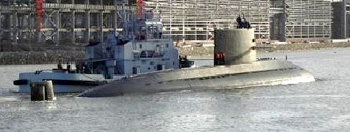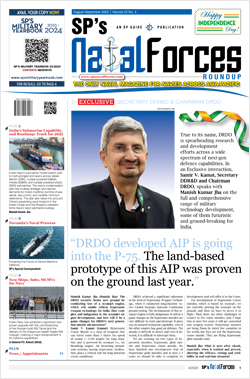INDIAN ARMED FORCES CHIEFS ON OUR RELENTLESS AND FOCUSED PUBLISHING EFFORTS

The insightful articles, inspiring narrations and analytical perspectives presented by the Editorial Team, establish an alluring connect with the reader. My compliments and best wishes to SP Guide Publications.

"Over the past 60 years, the growth of SP Guide Publications has mirrored the rising stature of Indian Navy. Its well-researched and informative magazines on Defence and Aerospace sector have served to shape an educated opinion of our military personnel, policy makers and the public alike. I wish SP's Publication team continued success, fair winds and following seas in all future endeavour!"

Since, its inception in 1964, SP Guide Publications has consistently demonstrated commitment to high-quality journalism in the aerospace and defence sectors, earning a well-deserved reputation as Asia's largest media house in this domain. I wish SP Guide Publications continued success in its pursuit of excellence.
- Operation Sindoor: Resolute yet Restrained
- Advanced MRSAM for India for a greater firepower
- Japan and India set forth a defence cooperation consultancy framework, talks on tank and jet engines
- Uri, Pulwama and now Pahalgam
- Terrorist Attack in Pahalgam in Kashmir: Unfolding a long surgical war against PAK
Chinese Submarines on the Prowl in Indian Ocean Region
 |
By Rear Admiral Sushil Ramsay (Retd.) Strategic Affairs Analyst |

Photo Credit: Wikipedia
Recent reports of a conventional Chinese submarine entering Karachi harbour in the last week of May and spending one week for replenishment and logistics turnaround has caused much consternation in the Indian security establishment. This was the second incidence of presence Chinese submarine in the backyard of India, the first being Chinese submarine visiting Colombo cargo terminal some nine months ago during September 2014. The major difference between the two visits was that in the first case India could lodge an official protest with the Sri Lankan Government for breach of a bi-lateral agreement between the two countries. However, in the instant case lack of similar instrument does not offer any option to India.
From China's maritime perspective the deployment of a Yuan-class 335 conventional submarine, equipped with torpedoes, anti-ship missiles and the air-independent propulsion (AIP) system which enhances the stealth features and underwater endurance of a conventional submarine, is of great strategic significance. China has been aspiring to demonstrate its maritime capability in the South China Sea, Malacca Strait, its adjoining waters and now the Indian Ocean Region (IOR) through the Gulf of Aden in the garb of anti-piracy campaigns. In that context China now has its proven doctrine. This is yet another indicator of the fast transformation of the People's Liberation Army-Navy, which operated close to its shores in the profile of Brown Water Navy, into a "Blue Water force with long legs that is expanding its presence in the IOR. China has claimed that such replenishment stopovers on way to the Gulf of Aden for escort and anti-piracy operations were a "common practice" for navies around the world. While there is no dispute over the claim, it is now an open secret that China is honing skills of long-range deployments of its nuclear and conventional submarines.
However, justifying such overseas deployments on anti-piracy missions should be viewed as blatant disclaimers of its actual intent. China's first-ever deployment of a Yuan class submarine to Pakistan acquires greater significance in the context of emerging reports that China will be selling some eight Yuan class submarines to Pakistan in the near future. Four submarines of this project will reportedly be manufactured indigenously in Pakistan. Fully loaded and equipped Chinese submarine reportedly spent a full week in Karachi port in the last week of May with entire crew of at least 65 on board. While such deployments are not unusual, it certainly accentuates China's increasing defence cooperation with Pakistan.
India presently has just 13 operational submarines as against China's 60. Pakistan, a much smaller country, has eight operational submarines as of now. China is racing ahead in adding more submarines to its fleet and should have 75 submarines by 2020. The emerging developments can only be countered by India rejuvenating her own indigenous 30-year submarine capability building plan. The prestigious Scorpene project is already beleaguered and the first platform of the line is expected to be delivered only towards the end of 2016. The delivery of the subsequent submarine is expected at an interval of nine months each with the completion of the project stretching to 2020.
In the recent past Defence Acquisition Council has approved a Request for Information for six more conventional submarines with AIP capability. Request for Proposal and Tendering process is still far out on the horizon. The Project 75I submarines are expected to be bigger than the 1800-ton Scorpene class currently under construction at MDL, Mumbai. The AIP systems will enable greater underwater endurance besides incorporating stealth, land-attack missiles capability and other technological advancements. Optimistically speaking the first Boat of Project 75I could be available not before 2025. The government has allocated $8.1 billion for the six submarines to be acquired.
Recently, Cabinet Committee on Security has approved plans for the indigenous development and construction of six nuclear-powered submarines. The plan to add six nuclear submarines is a modification of Government's decision taken last year for Project 75I. This initiative is an amalgamation of six nuclear submarines into 30-years submarine force building and modernisation perspective plan.
Taking serious note of these developments Admiral Robin Dhowan, Chief of the Naval Staff had recently said that the Indian Navy was "minutely and continuously monitoring" the presence of Chinese warships in the region to ascertain "what challenges they could pose for us".





